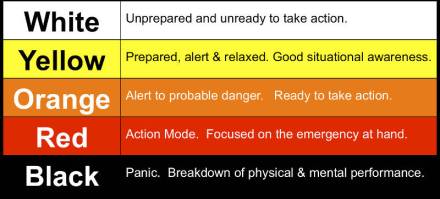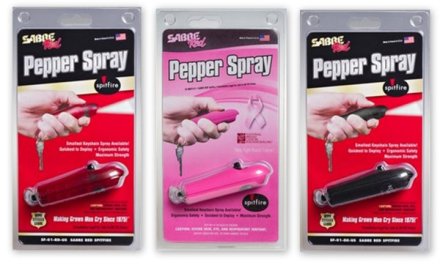I was at the gunshop today and was discussing 20ga vs 12ga (I’ll get back to that at a later date) when the topic of escalation of force came up. This is a topic that I don’t feel is discussed enough. Most likely because it doesn’t stroke the ego nor does it feed into the machismo of a lot of gun culture.
- When you are out and about, and you have all of your tools, gadgets and death-ray on you, you should, first and foremost, be aware of what is going on around you. That doesn’t mean stare everyone down like a deranged lunatic. It simply means, take notice of what is happening around you. Does someone look out of place or menacing? Is someone giving you hard looks? Are there any emergency personnel around (Police, EMT’s, Firefighters(most firefighters are cross-trained as EMT’s) that you could go to if something bad happens? Where are the entrances/exits or main areas of travel? Where will I be going in the case of an emergency? Keep in mind, that people tend to run toward the same door or direction they came/entered from in an emergency. There is almost always a back/side door (usually through the kitchen if you’re in a restaurant or the “backroom/loading dock” of most major stores) that you can get to and get out from quicker and easier. For those of you who are familiar with quality firearms training methodologies and tactics as it relates to mindset, you will know that this is Condition Yellow of Jeff Coopers color code. You should be in yellow for the vast majority of your day. Excluding when you are asleep of course.

When you find yourself encountering a potential threat or in an uncomfortable position, you need to know your options.
2.Verbally acknowledge the potential threat. (This could be as simple as putting both hands up toward your chest, palms out and saying “Could you stop right there please?) I am a fan of “Back up, feels like I’m about to throw up”. This is disarming without being threatening and if they continue to advance, some flags should start going up. A great class to take to get a more detailed grasp on this is “Managing Unknown Contacts (or MUC*pronounced muck*) with Craig Douglas of Shivworks.
3.The threat or badguy is still advancing after your verbal acknowledgment and it is obvious that bad things are to be expected, this is when I suggest we start using physical, less lethal, tools. Here is where pepper spray shines. Pepper spray utilizes the body’s own reactions to irritants to allow you an opportunity to get away from the altercation. There are several versions of spray, and several delivery methods. My personal favorite and what I suggest is the SABRE Spitfire. It is easily kept on a keychain and the delivery method is in a cone shaped mist. I like the mist because it is easier for the assailant or threat to inhale and isnt easily wiped off or avoided. It is accurate within 10ft. The only drawback is that it can be blown back into your face if the wind is blowing in that direction. Once you spray someone, immediately get out of the area and into a safe place and then contact the police. (If you happen to not have your spray on you, a quick fingertips forward thrust into the eyes with your off/weak hand can gain you a few valuable seconds if you connect. This is covered in depth in Craig Douglas’s ECQC and EWO classes)
4.If for whatever reason the pepper spray wasn’t effective, or you couldn’t use it and there is a legitimate threat against your life or the lives of others, now you can bring your gun into play (a knife is also a lethal option but is a really nasty and complicated option that I don’t suggest unless there are no other options. KNIVES ARE NOT LESS-LETHAL OPTIONS). Once this happens, there are still more options. Just because you have pulled your gun DOES NOT mean you have to use it, but you should be prepared to. Simply yelling STOP!!!!!! while presenting the gun might very well solve the problem at hand. There are many different ways for the situation to go. You prepare for this by taking quality training and utilizing dryfire exercises. I suggest Claude Werner’s 1000 days of dryfire. As far as quality training, I would be happy to help anyone I can. I also would highly recommend Craig Douglas of ShivWorks, Paul Sharp and his MDOC system, Claude Werner, Tom Givens of Rangemaster, Clint Smith of Thunder Ranch, John Farnham of Defense Training International, Paul Howe, Steve Fisher of Sentinel Concepts, Jeff Bloovman of Armed Dynamics, Mark Luell of Growing Up Guns,(Super) Dave Harrington, Reid Heinrichs of Valor Ridge, Jeff Gonzalez of Trident Concepts, and the list goes on and on. I have trained with several of these folks and would gladly send my loved ones to them for quality, realistic, robust training to trust their lives with.
(a knife is also a lethal option but is a really nasty and complicated option that I don’t suggest unless there are no other options. KNIVES ARE NOT LESS-LETHAL OPTIONS). Once this happens, there are still more options. Just because you have pulled your gun DOES NOT mean you have to use it, but you should be prepared to. Simply yelling STOP!!!!!! while presenting the gun might very well solve the problem at hand. There are many different ways for the situation to go. You prepare for this by taking quality training and utilizing dryfire exercises. I suggest Claude Werner’s 1000 days of dryfire. As far as quality training, I would be happy to help anyone I can. I also would highly recommend Craig Douglas of ShivWorks, Paul Sharp and his MDOC system, Claude Werner, Tom Givens of Rangemaster, Clint Smith of Thunder Ranch, John Farnham of Defense Training International, Paul Howe, Steve Fisher of Sentinel Concepts, Jeff Bloovman of Armed Dynamics, Mark Luell of Growing Up Guns,(Super) Dave Harrington, Reid Heinrichs of Valor Ridge, Jeff Gonzalez of Trident Concepts, and the list goes on and on. I have trained with several of these folks and would gladly send my loved ones to them for quality, realistic, robust training to trust their lives with.
A violent or volatile encounter is much more complicated than a 4 step process. I tried to boil it down to the main points of
- Be aware of your surroundings
- Let them know that you see them
- Have a less lethal option
- Have a lethal option
- JUST BECAUSE YOU SKIN YOUR SMOKE WAGON DOESNT MEAN THAT YOU NEED TO MAKE NOISE WITH IT
Hopefully this made sense to everyone and gives you a template for an escalation of force when presented with a violent or volatile encounter.
Thank you for reading. Share this if you found it helpful.
Best wishes to you as you pursue a classical education in violence.